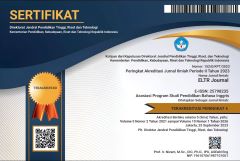WOMEN’S LANGUAGE FEATURES USED BY ENGLISH TEACHER CANDIDATES
DOI:
https://doi.org/10.37147/eltr.v2i2.99Keywords:
micro teaching, English teacher candidate, women's language featureAbstract
This paper discussed women’s language features used by female students in English Language Education Study Program (ELESP) as English teacher within teaching learning practices in micro-teaching class. The study aimed to investigate the frequency of the women’s language features and the possible reason of using the features by female students. The writer assumed that women have characteristics in speaking, including female English teacher candidates. Unconsciously, female English teacher candidates use some or all of women’s language features when they are doing teaching practice in Micro Teaching class. These features indicate that actually, if a woman or a female English teacher candidate uses most of the features, that she is not really sure about what she is uttering to the pupils in English learning activities. Besides that, a teacher should be confident in delivering materials or teaching the pupils. Those features have been discussed by Robin Lakoff in one of her books entitled Language and Woman’s place. In that book, she writes about ten language features which are usually used by the women when they are speaking. Therefore, it encouraged the writer to conduct a paper about women’s language used by female students in ELESP as English teacher candidates.
Downloads
References
Afrizal. (2014). Metode penelitian kualitatif (edisi kedua). Jakarta: PT Raja Grafindo Persada.
Chudgar, A. & Sankar, V. (2008). The relationship between teacher gender and student achievement: Evidence from five Indian states. Retrieved 26 September 2016, from http://iiste.org/Journals/index.php/JEP/article/viewFile/9054/9279.
Eckert, P. & Ginet, S. M. (2013). Language and gender. Cambridge: Cambridge University Press.
Edwards, J. (2009). Language and identity. Cambridge: Cambridge University Press.
Fillmore, C., Lakoff, G., & Lakoff, R. T. (1974). Berkeley studies in syntax and semantics, 1. Berkeley: Department of Linguistics and Institute of Human Learning University of California.
Fishman, P. (1983). Interaction: The work women do. In Barrie Thorne, Cheris Kramarae and Nancy Henley (Eds), Language, Gender, and Society, 88-103. Cambridge: Newbury House Publishers.
Lakoff, R. (1973). Language and woman’s place: Language in Society, 2(1), 45-80. Retrieved on Dec 3, 2015 from http://web.stanford.edu/class/linguist156/Lakoff_1973.pdf.
Talbot, M. (2010). Language and gender (2nd ed.). Malden: Polity Press.
Starks, H. & Trinidad, S. B. (2007). Choose your method: A comparison of phenomenology, discourse analysis, and grounded theory. Qualitative Health Research, 17(10), 1372-1380. DOI: 10.1177/104973230707031.
Wood, L. A. & Kroger, R. O. (2000). Doing discourse analysis. Thousand Oaks, CA: Sage Publication.
Downloads
Published
How to Cite
Issue
Section
License
Copyright (c) 2018 Elisabeth Wulan Wahyuningtyas

This work is licensed under a Creative Commons Attribution-ShareAlike 4.0 International License.













